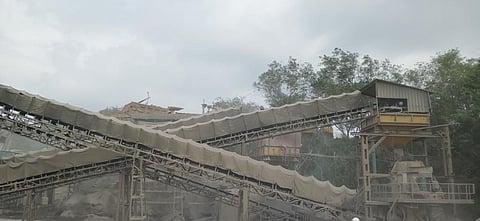This Pune stone-crusher unit shows how to do it properly
The stone-crushing industry receives a lot of negative attention for generating a huge amount of fugitive emissions that degrade air quality and the environment. However, one unit in Pune hopes to change this by providing an exemplary example of following good practices.
Illegal stone mining in protected areas has often been in the spotlight, with several cases filed with the National Green Tribunal and the Supreme Court.
Most stone crushers do not follow the state board guidelines for operation. They also do not take adequate measures of installing air pollution control devices and water sprinkling and dust extraction systems, which contribute substantially to air pollution.
Flouting of environmental norms by the stone-crusher units is regularly reported in the news too, with several cases are filed in the NGT. Pune has several classic examples of units flouting norms, especially in the Wagholi area, Lonikand, Bavadi village in Haveli taluka and Gevari taluka.
In 2016, the NGT had given directions to Maharashtra Pollution Control Board (MPCB) and Central Pollution Control Board in Uttamrao Vithalrao Bhondwe Vs state of Maharashtra and others case.
“Carry out a joint monitoring of 56 stone-crusher units in taluka Havali, district Pune and submit their report of joint inspection monitoring and cumulative impact assessment,” the NGT bench had directed.
The joint committee was also asked to “carry out ambient air quality monitoring in the nearby areas where the stone crusher units are situated and also to identify possible sources of air pollution in those localities.”
Many stone-crusher units did not adhere to the state guidelines, the study report found. MPCB had to issue a blanket ban on working stone crushers and cut down the power supply.
However, one stone-crusher unit in village Mangrul in Malwal taluka of Pune district was a guiding light for all stone crushers. The unit strictly adhered to MPCB guidelines for operating crushers and works on the best operating practices.
The cherry on the cake is that the unit ran on solar energy as well as on electricity. During closure and breakdown time, the unit returned the electricity to the Maharashtra State Electricity Board.
The unit has two crushers with a capacity of 200 tonnes per hour (tph) each and another with a capacity of 300 tph. It has a ready-mix concrete (RMC) plant of 120 tph in addition to this.
Currently, the RMC is for in-house purposes because they are making a storage plant to store final products in a closed space.
Adherence to MPCB norms
Despite such a huge capacity, the unit adheres to the MPCB guidelines and also takes some other good steps to save energy and reduce air pollution and fugitive emissions.
The sitting criteria of the unit were strictly adhered to as per the guidelines. The unit was 1 kilometre away from the national highway and 500 metres away from the state highway, schools, hospitals and human habitation.
Steps taken by the unit for adhering to MPCB guidelines
| Parameters | Steps taken |
| Conveyor belts | Covered with GI/MS sheets |
| Water sprinklers | Available at unloading, handling, and loading section |
| Screen classifiers | Fully covered with GI/MS sheets |
| Wetting of the road | On regular basis with sprinklers |
| Approach road | Metalled roads |
| Display Board | Available at the entrance of the unit |
| Boundary wall | All sides covered with 10 feet wall |
| Plantation | The thick foliage of the plants along the periphery |
| Housekeeping | Regularly on a daily basis |
| Operating time | 7 am to 6 pm |
Energy saving
Installation of two solar plants, each of 1 megawatt capacity, helps the unit conserve energy. One plant was installed in 2018 and the other in 2021. The solar plants are constructed over the stone quarry, which has been previously used by the unit.
The cost of installing the solar plant was around Rs 6 crore and the plant generates around 1.5 million units every year.
Maintenance of solar panels in the area surrounded by the crusher units and quarries is a challenging task, as huge amounts of dust got accumulated on the solar panels and hampered energy generation. However, unit combats this with regular washing and wiping.
Washing of solar panels. Photo: Divyansh Upadhyay
Some of the steps taken by the unit to follow best practices are:
- Cleaning of solar panels
- Covered conveyor belts
- Regular wetting of roads
- Display board outside the industry
- Thick foliage of plants along unit's periphery
- Sprinklers along the roadside
The above-mentioned case study should be highlighted and propagated to wider audiences. Global good operating practices should be documented as well.
Such holistic documents will help the sector, maximize explicit knowledge and will enable other industries to benefit from exchanging experiences with one another. The documentation should help develop and implement solutions adaptable to similar problems in different situations and contexts.
Exposure visits should be conducted for regulators and industry professionals, accompanied by training programmes, to showcase the ongoing good practices prevailing in different industries.
By adapting to good practices, the stone-crusher industry can enhance their feasibility and profitability and can set an exemplary example in front of other industries.

